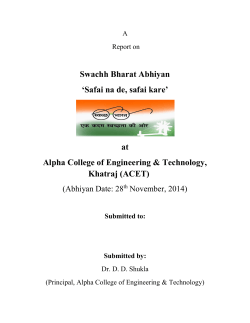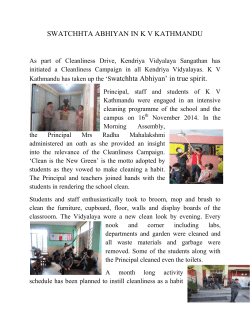
“SuPoSHaN” ABHIYAN
ICDS MISSION
“SuPoSHaN”
Community Based Intervention
- Curative Strategy : Sneha Shivir (VHNCCS)
- Preventive Strategy : 20 Counseling sessions,
25 IEC Sessions
6 VHNDs
VIDEO CONFERENCE 31.01.14
CRITICAL INDICATORS
PARTICULARS
Prevalence of low birth weight
Initiation of Breast feeding with in 1 hour
Pre-lacteals given
Exclusive Breastfeeding (0-5 months)
Initiation of compl. feeding At 6 months
% Full Immunization ( 12-24 months
children)
Coverage of 9-59 months children for
Massive Dose Vitamin A Supplementation
(%)
Coverage of Pregnant women for IFA Tablet
Distribution (%)
Coverage of 12-59 months children for IFA
Tablet/Liquid Distribution (%)
INDIA
NFHS - 3
(Rural 2005-06)
23.4
46.3
55.8
43.5
M.P.
NFHS - 3
(Rural 2005-06)
23.4
13.3
58.7
21.6
31.5
-
NIN (2010)
19.1
26.4
16.1
71.0
23.5
84.2
-
81.7
-
-
78.0
-
-
25.0
Nutrition status (Based on WHO Child Growth Standards - 2006)
Underweight
Stunting
Wasting
45.9
38.4
19.1
60.0
50.0
35.0
51.9
48.9
2
25.8
Age Group wise Percentage of Underweight
Children (0-5 years)
M.P. v/s India (NFHS-III 2005-06)
20
64.9
61.2
61.8
•
Undernutrition in the first 5 years (esp. first 2 years) of life60.7
47.6
needs special53
emphasis.
44.8
•
Lifelong adverse impact on growth and development
45.6
44.9
43
•
Higher risk35.7
of dying in infancy
• 29.5
Consequences are severe & often irreversible
10
•
70
% of Children
60
50
40
30
0
Lifelong cognitive and physical deficits and chronic health
problems
<6
6-11
12-23
24-35
36-47
48-59
Age (months)
India
Madhya Pradesh
Data Source: NFHS-3 (2005-06)
VISION 2018
• iks"k.k lq/kkj ds çHkkoh gLr{ksi
– dqiksf"kr cPpksa dh ns[kHkky ds fy;s xzke Lrj ij Ms ds;j lsaVj LFkkfir djus ds fy;s xzke vkjksX;
dsUæksa ds ek/;e ls leqnk; dks lfEefyr djuk
– ifjokj vk/kkfjr i)fr ls dqiks"k.k ds dkj.kksa dks nwj djus gsrq cgq&{ks=d dsUækfHkeq[k
xfrfof/k;ksa dklapkyuA
– fodsfUær ,oa çklafxd i)fr ls lkeqnkf;d xfrfof/k;ksa }kjk iks"k.k lEcU/kh ;kstukvksa dk
dk;kZUo;uA
– vkbZlhMh,l ds varxZr csgrj lsok,a miyC/k djkus ds fy;s vkaxuokM+h dk;ZdrkZ dks xzke lHkk
LOkLF; xzke rnFkZ lfefr ds fodsUnzhd`r ek/;e ls lqfo/kkvksa esa c<+ksRrjhA
– O;ogkj ifjorZu gsrq LoLFk f'k'kq izfr;ksfxrk] ekr`Ro ,oa f'k'kq lEesyu tSlh xfrfo/k;ksa dk vk;kstuA
– iks"k.k xfrfof/k;ksa ds csgrj fØ;kUo;u ,oa dqiks"k.k esa deh ykus ds iz;klksa gsrq fo'ks"k fuxjkuh
ra= dh LFkkiukA
5
OBJECTIVES
“SuPoSHaN”
Abhiyan
fpagkfdr vfrde otu ds cPpksa dk leqnk; dh fuxjkuh esa
Supportive
iks"k.k izca/ku
Programme
on
ekrk&firk
dks
LokLF;
,oa
iks"k.k
Lrj
dks
lq/kkjus
gsrq
Sustaining
“SuPoSHaN”
ijke'kZ nsdj muds O;ogkj esa ifjorZu ykuk
Health
and & leqnk; dks xzke esa vfrde otu ds cPpksa gsrq "SuPoSHaN"
Nutrition
dk;Z;kstuk cukus ,oa fdz;kUo;u gsrq l{ke cukuk
& dqiks"k.k eqDr xzke ds fy;s leqnk; dks l{ke cukuk
NUTRITIONAL STATUS OF
CHILDREN (0-5 YEARS)
32.7 32.1
Only 15% needs facility
care
27.3
26.7
26.3
22.4
19.8
22.2
23.7
17.5
12.6
8.3
Severe UW
Moderate UW
Underweight
(Weight-for-Age)
Severe Wasting
Moderate
Wasting
Severe Stunting
Wasting
(Weight-for-Height)
NFHS III (2005-06)
Moderate
Stunting
Stunting
(Height-for-Age)
NIN Survey (2009-10)
WHO Growth Standards (2006): MODERATE = Median <-2 SD to ≥ -3 SD &
SEVERE = Median <-3 SD
8
“SuPoSHaN” ABHIYAN
‘Abhiyan' for reduction and prevention of undernutrition
Conceptualized as a community based programme
Targeted convergent approach
Targeted to 14698 (70% undernutrition) AWCs - 4 or more SUWs
Rastriya Bal Swasthya Kariyakram (RBSK) and C-NRC of NRHM
“Sneha Shivir” , Mangal Diwas, IEC, ABM
Adapted from globally acknowledged Positive Deviance
Approach
d.
ftyk
dsUnzz
SUW>=4
1
2
3
7
8
9
10
11
12
13
14
15
16
17
18
19
20
21
22
23
24
25
26
27
bankSj
[kaMok
[kjxkSu
nsokkl
uhep
eanlkSj
jryke
'kktkiqj
vkxj
xquk
nfr;k
f'koiqjh
fHk.M
eqjSuk
';ksiqj
dVuh
fNanokM+k
tcyiqj
fM.MkSjh
jktx<+
jk;lsu
fofn'kk
lh/kh
mefj;k
234
219
1151
430
265
369
915
329
195
277
102
628
53
236
161
471
100
144
44
400
92
57
208
205
izFke pj.k ds izLrkfor
vkaxuokM+h dsUnz
d.
64
59
75
65
38
64
66
31
20
45
32
76
84
82
37
61
108
89
64
87
55
77
72
26
28
29
30
31
32
33
34
35
36
37
38
39
40
41
42
43
44
45
46
47
48
49
50
51
ftyk
dsUnzz
SUW>=4
Vhdex<+
neksg
iUuk
gks'kaxkckn
vyhjktiqj
/kkj
cqjgkuiqj
v'kksduxj
Xokfy;j
ujflagiqj
ckyk?kkV
eaMyk
flouh
Hkksiky
lhgksj
jhok
lruk
flaxjkSyh
vuwiiqj
'kgMksy
Nrjiqj
lkxj
cSrwy
gjnk
150
101
115
77
441
1425
399
136
143
46
67
54
75
202
89
195
424
285
77
133
342
290
34
36
izFke pj.k ds izLrkfor
vkaxuokM+h dsUnz
57
58
44
62
46
141
30
31
48
41
97
72
72
65
44
111
112
54
41
50
76
88
89
24
“SuPoSHaN” ABHIYAN
‘Abhiyan' for reduction and prevention of undernutrition
Conceptualized as a community based programme
Targeted convergent approach
Targeted to 14698 (70% undernutrition) AWCs - 4 or more SUWs
Rastriya Bal Swasthya Kariyakram (RBSK) and C-NRC of NRHM
“Sneha Shivir” , Mangal Diwas, IEC, ABM
Adapted from globally acknowledged Positive Deviance
Approach
What is Positive
Deviance?
• Every community has certain individuals or groups whose
uncommon behaviors and strategies enable them to find
better solutions to problems than their peers, while having
access to the same resources and facing similar or worse
challenges.
• Based on problem-solving and community-driven approach
that enables the community to discover these successful
behaviors and strategies and develop a plan of action to
promote their adoption by all concerned.
STRATEGIES
Participatory Micro
Planning at Village level
1. Community
Mobilization
• Facilities
improvement
• Weighing drive
2. Village Mapping
3. Screening of children
• Presence of health
worker
at
1st
screening
• Provision of 1st round
of medication during
special VHNDs (17th
– 24th)
4. Steered
by
AWW,
Gram Swasthya Samiti
and Poshan Mitra Team
STRATEGIES
Participatory Micro
Planning at Village level
1. Community Mobilization
• Facilities
improvement
• Weighing drive
2. Village Mapping
3. Screening of children
• Presence of health
worker
at
1st
screening
• Provision of 1st round
of medication during
special VHNDs (17th
– 24th)
4. Steered
by
AWW,
Gram Swasthya Samiti
and Poshan Mitra Team
Curative
Entry point to the village
for accelerated reduction
in moderate and severe
under
nutrition
in
children
Steered by Supervisor
and Poshan Sahyogini
Curative Strategy
Sneha Shivir + C-NRC
• 1st & 30th day Doctor completes screening, tracks status
• 12 days camp for 10-15 children
• Supervisors and Poshan Sahyogini conduct the camp
– 3 Supervised feeding of children
– Focused counseling session of mothers with PD exemplars
– Demonstrating local nutritious recipes - Mothers Learn by
doing
– Day to day child profiling
• Poshan Mitra, ASHA, AWW follow up by 18 home visits
• Monthly follow up and weighing of children for 6 months
• If required re-organize camp
STRATEGIES
Participatory Micro
Planning at Village level
1. Community
Mobilization
• Facilities
improvement
• Weighing drive
2. Village Mapping
3. Screening of children
• Presence of health
worker
at
1st
screening
• Provision of 1st round
of medication during
special VHNDs (17th
– 24th)
4. Steered
by
AWW,
Gram Swasthya Samiti
and Poshan Mitra Team
Curative
Entry point to the village
for accelerated reduction
in moderate and severe
under
nutrition
in
children
Steered by Supervisor
and Poshan Sahyogini
Preventive
Empowering community
to
catalyze
behavior
change for taking out the
village
from
the
undernutrition trap
Steered by AWW, Gram
Swasthya
Samiti
and
Poshan Mitra Team
Preventive Strategy
• Life cycle approach for improving nutrition
– Continuum of care beginning with adolescent girls to first
1000 days and till 5 years of age
FIRST 1000 DAYS
•
Pregnancy (9 months 30 x 9 = 270)
•
Birth – 24 months ( 24 x30 = 720 days)
•
Total = 1000 days
•
To increase children’s chances of survival, improve
development
and
interventions
need
prevent
to
be
stunting,
delivered
nutrition
during
the
mother’s pregnancy and the first two years of the
child’s life.
Preventive Strategy
• Life cycle approach for improving nutrition
– Continuum of care beginning with adolescent girls to first
1000 days and till 5 years of age
• Strengthen and streamline delivery of ICDS
– Universal survey and enrolment of beneficiaries at AWC
– Vajan Mela every every month 1st to 4th
– Screening of children by health care providers and referrals
– Swachhata Abhiyan every month 5th to 7th
– Targeted activities Monday to Friday
Targeted activities Monday to Saturday
Days
Targeted Activities
Monday
Regular dialogue with community - Special VHNDs + Poshan
Meetings with gram swasthya samitis and poshan mitra
Tuesdays
Lakshit Mangal Diwas
campaign
Wednesday
Intensive home visits targeted to Pregnant women
Thursdays
Intensive home visits targeted to lactating mothers of
children 0 to 6 months
Fridays
Advocacy and dialogue with community for behavioral
change - 25 IECs
Saturday
Intensive home visits targeted to lactating mothers of
children 6 months to 2 years
- 20 themes along with sanitation
Support - "SuPoSHaN“ Abhiyan
Village level
•
•
•
•
Sector Level
AWW
• Supervisor
AWH
• ANM
ASHA
• NGO
Gram Sabha
nominated by
Swasth Gram
District
Tadarth Samiti
officials
• Poshan Mitra
Team
• PRI
Block Level
•
•
•
•
BMO
CEO JP
Project Officer
Mobile health
team
District Level
•
•
•
•
•
•
•
•
•
CEO ZP
EE PHE
CMHO
DD Agri/Horti
Food Officer
DPO
AWTC
DTO (Health)
Home science
faculty
OUTCOME
Sr.
no.
Out come indicators
Target
1
Weight gain of children
after 12 days
75%
children
will
show
minimum 200 gm weight gain
2
Weight gain of children
after 30 days
75%
children
will
show
minimum 400 gm weight gain
3
Weight gain of children
after 2 months
Growth curve
children will
trajectory
4
Weight gain of children
after 3 months
50% children will show positive
change in nutritional status
5
Nutritional status of
children after 6 months
80% children will show positive
change in nutritional status
of
on
75% of
positive
22
Phase Out Strategy
• Success in a village will be assessed
– by complete elimination of SUW
– decrease in MUW
• Exit strategy after 1 year of implementation of Sneha Shivir in
any village
– Weighing all eligible children (0-5 yrs)
– Third party would conduct the “audit”
– If no cases of severe under nutrition and borderline moderate
cases for a period of one year it may be decided to phase out
Sneha Shivir
– Remaining MUW children would be rigorously monitored and
care givers counselled on best practices at regular health
education sessions and during home visits
IMPERATIVES
•
Active involvement of Health, Panchayats, PHE,
Agriculture, Food
•
Community participation through poshan mitra team,
gram sabha swasth gram tadarth samiti
•
Sensitive Poshan Sahyogini
•
Quality training
•
Good Micro-planning and implementation
•
Intensive monitoring
•
Adequate and timely resources
TIME LINES
• March - 3035 camps in 1st phase in 2 cycles
– Cycle 1 : March 1 to March 12
– Cycle 2 : March 24 to April 4
• January and February
– Selection of villages, Poshan Sahyogini and Poshan Mitra
– Trainings at all level
– Microplanning
– Preliminary screening of children and medication
• April - Preparation for 2500 camps in May (1-12th)
• May - Phase 2 camps and Preparation for 2500 camps in
June (1-12th)
Expectations From
Collectors
• Build and mobilize for enabling environment and community
participation
• Strengthening convergence with
–
–
–
–
–
Health for screening and monitoring
Panchayat for infrastructure, facilities and participation - employment
PHED for Safe drinking water and sanitation campaign
MDM for improved Hot supplementary nutrition given at AWC
Agriculture for minikits / Food for PDS
• Monitor ICDS to ensure :
– Universal survey, identification and weighing
– Quality of training and inputs of Abhiyan
– Delivery of services including THR
• Provide administrative, technical and financial sanctions for
the optimum usage of resources
© Copyright 2025














